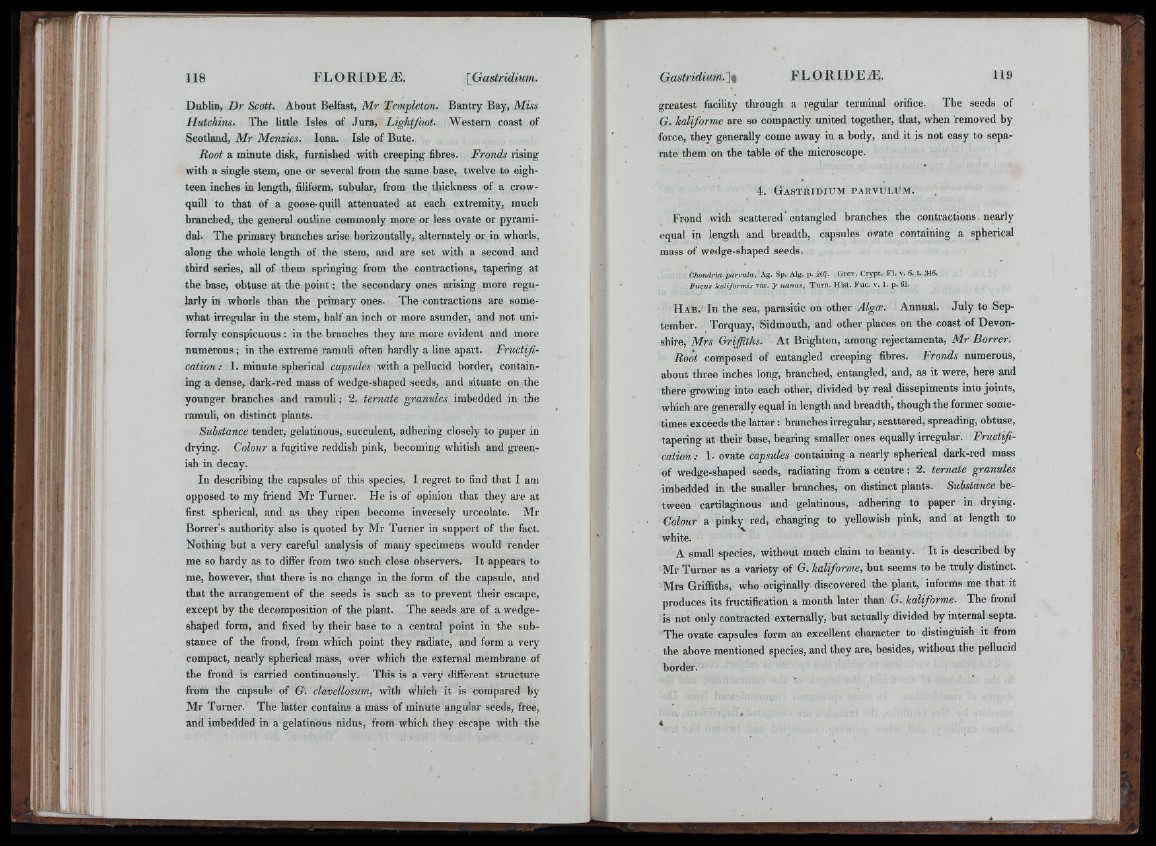
Dublin, Dr Scott. About Belfast, Mr Templeton. Bantry Bay, Miss
Hutchins. The little Isles of Jura, Lightfoot. Western coast of
Scotland, Mr Menzies. Iona. Isle of Bute.
Root a minute disk, furnished with creeping fibres. Fronds rising
with a single stem, one or several from the same base, twelve to eighteen
inches in length, filiform, tubular, from the thickness of a crow-
quill to that of a goose-quill attenuated at each extremity, much
branched, the general outline commonly more or less ovate or pyramidal
The primary branches arise horizontally, alternately or in whorls,
along the whole length of the stem, and are set with a second and
third series, all of them springing from the contractions, tapering at
the base, obtuse at the point; the secondary ones ar ising more regularly
in whorls than the primary ones- The contractions are somewhat
irregular in the stem, half an inch or more asunder, and not uniformly
conspicuous: in the branches they are more evident and more
numerous; in the extreme ramuli often hardly a line apart. Fructif-
cation: 1. minute spherical capsules with a pellucid border, containing
a dense, dark-red mass of wedge-shaped seeds, and situate on the
younger branches and ramuli; 2. ternate granules imbedded in the
ramuli, on distinct plants.
Substance tender, gelatinous, succulent, adhering closely to paper in
drying. Colour a fugitive reddish pink, becoming whitish and greenish
in decay.
In describing the capsules of this species, 1 regret to find that I am
opposed to my friend Mr Turner. He is of opinion that they ar e at
first spherical, and as they ripen become inversely urceolate. Mr
Borrer’s authority also is quoted by Mr Turner in support of the fact.
Nothing but a very careful analysis of many specimens would render
me so hardy as to differ from two such close observers. It appears to
me, however, that there is no change in the form of the capsule, and
that the arrangement of the seeds is such as to prevent their escape,
except by the decomposition of the plant. The seeds are of a wedge-
shaped form, and fixed by their base to a central point in the substance
of the frond, from which point they radiate, and form a very
compact, nearly spherical mass, over which the external membrane of
the frond is can-ied continuously. This is a very different structure
from the capsule of G. clavellosum, with which it is compared by
Mr Turner. The latter contains a mass of minute angular seeds, free,
and imbedded in a gelatinous nidus, from which they escape with the
greatest facility through a regular terminal orifice. The seeds of
G. kaliforme are so compactly united together, that, when removed by
force, they generally come away in a body, and it is not easy to separate
them on the table of the microscope.
4. G a s t r id iu m p a r v u l u m .
Frond with scattered'entangled branches the contractions. nearly
equal in length and breadth, capsules ovate containing a spherical
mass of wedge-shaped seeds.
Chondria parvula, Ag. S p . A lg . p . 207- G r e v . C r y p t . F I. v . 6. t. 346.
Fucus kaliformis v a r . y nanus, T u r n . H i s t . F u c . v . 1. p . 61.
H a b . In the sea, parasitic on other Algce. Annual. July to September.
Torquay, Sidmouth, and other places on the coast of Devonshire,
Mrs Griffiths. At Brighton, among rejectamenta, Mr Borrer.
Root composed of entangled creeping fibres. Fronds numerous,
about three inches long, branched, entangled, and, as it were, here and
there growing into each other, divided by real dissepiments into joints,
which are generally equal in length and breadth, though the former sometimes
exceeds the latter: branches irregular, scattered, spreading, obtuse,
tapering at their base, bearing smaller ones equally irregular. Fructification
: 1- ovate capsules containing a nearly spherical dark-red mass
of wedge-shaped seeds, radiating from a centre; 2. ternate granules
imbedded in the smaller branches, on distinct plants. Substance between
cartilaginous and gelatinous, adhering to paper in drying.
Colour a pinky red, changing to yellowish pink, and at length to
white.
A small species, without much claim to beauty. It is described by
Mr Turner as a variety of G. kaliforme, but seems to be truly distinct.
Mrs Griffiths, who originally discovered the plant, informs me that it
produces its fructification a month later than G. kaliforme. The frond
is not only contracted externally, but actually divided by internal septa.
The ovate capsules form an excellent character to distinguish it from
the above mentioned species, and they are, besides, without the pellucid
border.